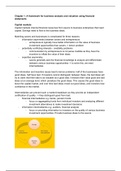Samenvatting
Summary: Financial statement analysis; Business Analysis and Valuation: IFRS edition
- Vak
- Instelling
- Boek
Summary of Financial statement analysis, master course for Banking and Finance, and Financial management at the University of Utrecht. It entails Chapter 1-8. It covers the book Business Analysis and Valuation: IFRS edition, 5th edition.
[Meer zien]




